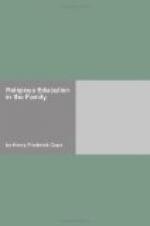The child has a right to the Bible as his literary heritage. Here in the Bible is the precipitation of the ideals of a people unique in the place which religion held in their lives. Here is a literature which is the source of much of the best in the language and reading of the child’s life. Its phrases are beautiful and convenient embodiments of religious ideals; they will have a steadily developing richness of meaning as life opens out to the child.[21]
Sec. 2. DIFFICULTIES
The difficulties in the way of the use of the Bible in the home are: the crowded programs, or a lack of time due to the absence of any program for the days; a feeling of unnaturalness in the special reading of this book; the decay of the custom of reading aloud; parental ignorance of the Bible and especially of its beauties for the young; and the excessive amount of task-reading frequently required by the schools. The Sunday school also sometimes offends in this respect by overemphasis on academic tasks for home work.
Sec. 3. METHODS
First, let parents use the Bible themselves. Use the books as you wish children to use them. This will be the longest step you can take toward the solution of the problem.
Secondly, use the Bible naturally. When children have an aversion to the Bible it is due usually to two causes: the peculiar place and use of the book which makes it a thing apart from life, and often an object of dread; and the practice of using it as a task-book, to be opened only in order to prepare Sunday-school lessons. Just as it takes years to overcome the aversion set up against English literature by its analytical study in the schools, so that the child becomes a man before he voluntarily reads Dickens, Thackeray, the poets, and essayists, in the same manner we have succeeded in making the Bible undesirable to youth. If you read passages aloud, use the tone of voice which would be appropriate if this was a new book not bound in leather. Read it for pleasure as one would read a literary masterpiece—not because opinion might frown on you if you had not read the classic. Does someone object that that would be to degrade the Bible to the level of secular writings? You cannot degrade a literature; it makes its own level and our labels do not affect it. Certain it is that a pious tone of voice will not protect the Bible from the secular level. But to use it unnaturally will degrade it in the opinion of those who hear us.
Thirdly, make its use a pleasure. All children enjoy story-telling and listening to reading. Many parents practice the children’s hour, some period in the day when they will, alone with the children, read and talk with them. Let the Bible story be the reward of a good day, something promised as an incentive to good behavior. Children delight, not alone in the story itself, but in rhythmic passages, in the poetic flights of Isaiah and the beautiful imagery of the Psalms. To them it is natural and pleasant to think of the hills that skipped and the stars that sang and the trees that gave forth praise. They know the song of nature and are happy to find it put into words.




